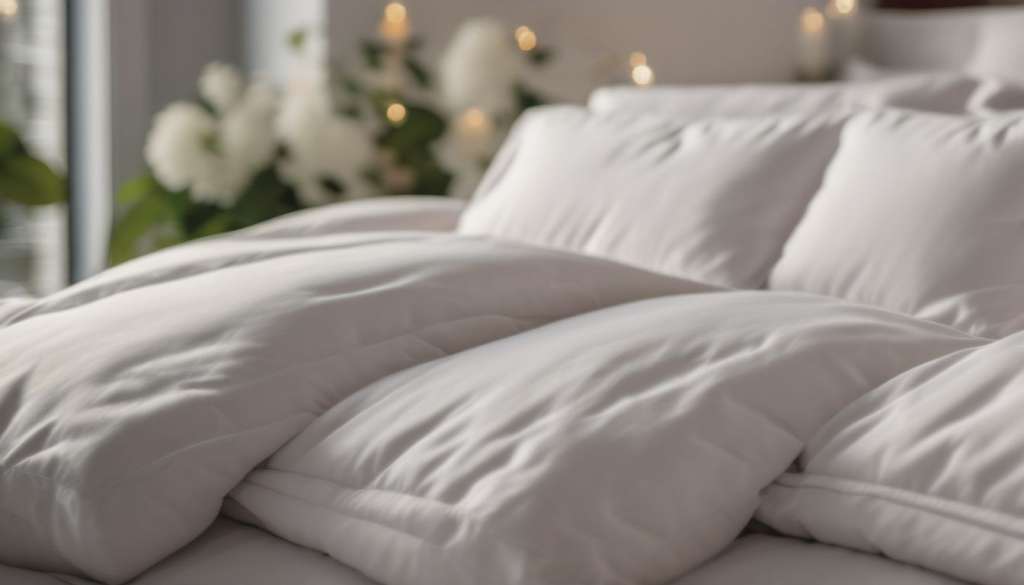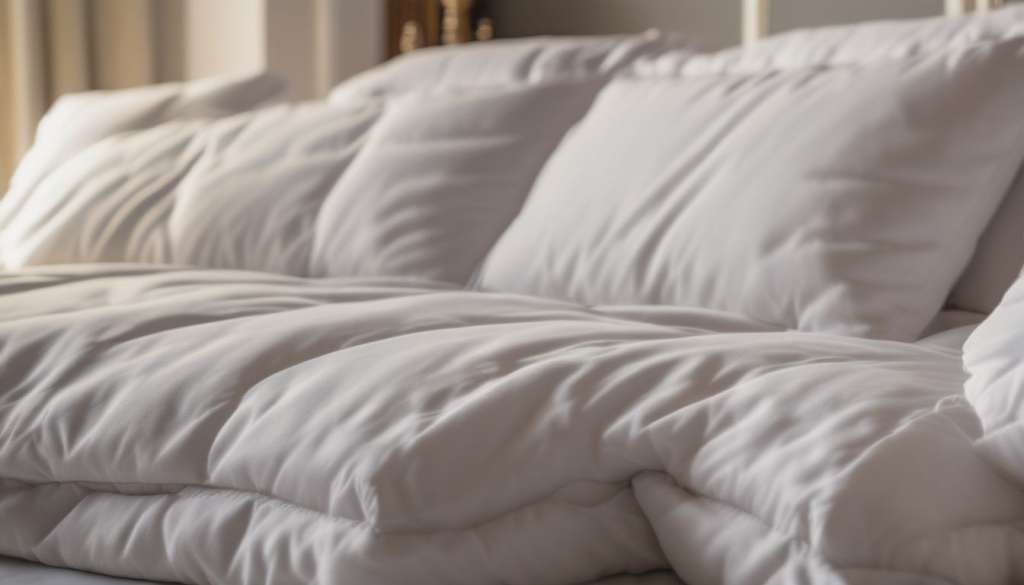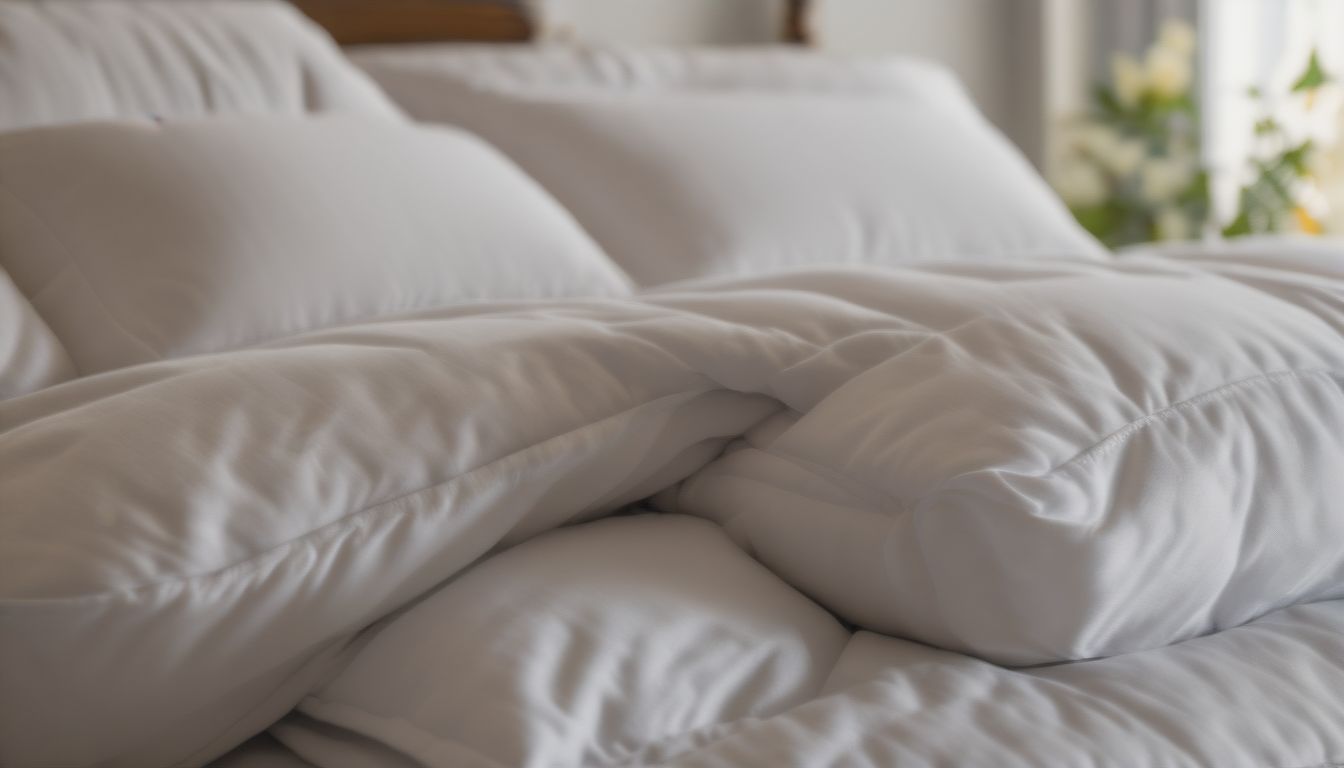Do you love the fluffy comfort of a down-filled comforter but hate the crinkly noises that seem impossible to avoid? You’re not alone. Many people adore the warmth, softness, and luxury feel of quality down bedding but end up frustrated by disturbances from fill shifting and fabric sounds at night.
Luckily, there are ways to reduce noise and improve your sleep experience. This in-depth beginner’s guide covers everything you need to know, from common causes of down comforter noise to actionable tips for preventing crinkles and rustles so you can truly enjoy that cloud-like comfort night after night.
What Causes Noise in My Down Comforter?
It’s not your imagination – there are real reasons why down comforters are prone to extra noise compared to other types of bedding:
Movement and Turning Over
All that cushy comfort comes from the fill shifting around. So whenever you move or roll over, the down and feathers will resettle causing some audible swishing. This is especially noticeable in larger comforters.
Cabin Noise Amplification
In cozy cabins or quiet bedrooms, even subtle noises seem amplified. The crinkling fabric of many down comforters is more evident compared to noisy city apartments. Wooden floors and sparse furniture allow sounds to carry.
Crinkly Fabric
Cheaper down comforter fabric tends to be extra stiff and crinkly. As you move around under the covers, the outer shell will crinkle instead of gently flexing, adding to noise issues.
Benefits that Still Make Down Comforters Worth It
Despite their tendency to be audibly “active” at night, quality down comforters offer special perks that can make them the best comforter choice:
Unbeatable Warmth for Cold Nights
The fluffy fill inside down comforters traps air exceptionally well to provide superior insulation. This allows the fill to retain heat and maintain that warmth longer through the night.
Aesthetic Appeal and Luxury Feel
Few other fabrics replicate the irresistible softness of down and feather bedding. When well-constructed, down comforters have a fluffy, billowy aesthetic that looks simply divine draped on the bed. Paired with silky smooth sateen shell fabrics, they scream luxury and opulence.
More Sustainable than Synthetics
Well-sourced down and feathers use natural materials that can biodegrade when disposed of properly, unlike synthetic polyester fibers that add to landfills. The longest lasting and highest quality down can be responsibly harvested as a byproduct of the food industry without harming animals.
Types of Down Comforters
Not all down comforters are equally noisy. High quality construction and materials make a big difference in limiting that crinkling racket at night. Two popular options that prioritize noise reduction include:
The Company Store Legends Hotel Down Comforter
- 650 fill power white goose down
- Available in lightweight to ultra-warm
- Baffle box stitching
- 330 thread count cotton sateen shell
- 5-year warranty
The Company Store comforters specifically feature firmly packed down fill with quality stitching and outer materials to minimize noise. The fail-proof reputation makes it a top choice for maximizing cozy comfort without disruption.
“This comforter is amazing quality, lightweight warmth and stays fluffy after washing. Worth every penny for a great night’s sleep!” – Sarah, verified customer
Brooklinen Down Comforter
- 700 fill power Hutterite white goose down
- Light, all-season, and ultra-warm weights
- Baffle box construction
- 400 thread count cotton sateen shell
- Lifetime warranty
Brooklinen is known for premium quality bedding designed to prevent noise disturbances. Their comforters use extra-long staple down clusters and durable fabrics engineered for strength, breathability and noise reduction. The lifetime warranty guarantees years of blissful and quiet comfort.
“So happy with this comforter! It’s the perfect weight and keeps me nice and cozy without overheating. No noise or shifting inside.” – Amanda, verified customer

What Makes Some Down Comforters Quieter?
To choose a down comforter optimized for peaceful and undisturbed sleep, pay attention to these key features:
Fill Power
This indicates the fluffiness and insulation ability of the down fill. Higher numbers like 600-800+ mean better quality down that will shift less inside the comforter.
Baffle Box Construction
Small fabric boxes sew the down into sections so it stays evenly distributed instead of bunching up. This prevents shifting which reduces rustling noises.
Shell Fabric
Smoother, denser shell fabrics (at least 300 thread count cotton sateen or silk) move more quietly against sheets. They also prevent fill leakage leading to less noise.
Things to Consider When Buying a Down Comforter
Keep these factors in mind depending on your sleep needs and bedroom environment:
Insulation Level Needed
Do you sleep hot or cold? Lightweight or ultra-warm fill suits different comfort preferences.
Allergy Concerns
Look for hypoallergenic options with strictly feather-free down alternative fills if allergies are an issue.
Bed Size
King and Queen comforters make more noise as they require more fill. Size down for less shifting.
Climate
In damp climates, moisture-resistant covers prevent fill clumping from humidity. This keeps the fluff evenly distributed.
Budget
Higher fill powers and thread counts run $150+ but promise lasting performance and durability.
Keeping Your Down Comforter Noise-Free
Proper maintenance is key to preserving that dreamy comfort while avoiding shifting Issues over time:
- Only dry clean down comforters to prevent fill clumping
- Use low heat air fluff settings if machine drying
- Store flat during warmer months to maintain loft
Also add a cover as a barrier layer to prevent irritation from crinkly fabric while catching any stray feathers. Soft jersey cotton is a quiet, breathable choice.
Troubleshooting Down Comforter Noises
If your down comforter starts making annoying noises that disrupt sleep, try these tactics before giving up on it completely:
Fluff Vigorously
Use your hands to plump any flattened sections so fill redistributes.
Air Out
Leaving the comforter uncovered lets trapped moisture or odors dissipate.
Add Fill
For older comforters, having more down added by a professional can reduce empty spaces where shifting occurs.
Replace Cover
Try encasing it in a new, soft fabric cover for a noise barrier option.
Be a Conscious Down Comforter Consumer
More people are prioritizing ethical and eco-friendly sourcing when buying down:
- Seek responsibly sourced down from suppliers with animal welfare guarantees
- Support brands that use biodegradable materials with minimal chemical processing
- Check certifications like Responsible Down Standard (RDS) for animal welfare assurances
- Choose local materials and manufacturing when possible to reduce transportation pollution
Buying durably constructed down comforters also ultimately generates less waste over time while supporting fair labor practices. With some savvy shopping, you can find options that feel as good ethically as they do comfort-wise.

The Bottom Line on Peaceful, Noise-Free Sleep
While even the highest quality down bedding may make subtle shifts and stretches as you sleep, options exist to minimize bothersome noise issues. Premium materials, baffle box construction, breathable shell fabrics and proper care all make a difference in reducing that middle-of-the-night crinkling.
So take your time selecting a down-alternative comforter or responsibly produced, ethically sourced down option that meets your needs. Then relax into the welcoming warmth and comfort you deserve without any audio disruptions. Sweet dreams!
Frequency Asked Questions
Still seeking solutions for a quieter, cozier night’s sleep? Here are answers to some other common questions about preventing noise from down-filled bedding:
Why does my down comforter make so much noise compared to other blankets?
The loose down filling shifts around easily inside the outer shell as you move in bed. This generates soft swishing and crinkling sounds absent in solid fiber blankets. Lower quality, lightweight shell fabrics also amplify noises.
How can I make my down comforter quieter when I move?
Choose a comforter with baffle box construction to limit fill shifting, and a tightly woven, high thread count cotton shell to muffle fabric noises. Adding a jersey cotton cover provides extra sound dampening as well.
What thread count cotton is the most quiet?
Experts recommend choosing down comforter shell fabrics with at least 300 thread count cotton sateen. The higher the thread count, the denser and more noise reducing the fabric. Lightweight percale cotton also stays quieter than stiffer twills.
Should I get a bigger/smaller down comforter to reduce noise?
Yes! Oversized comforters allow more shifting room so the fill rustles more as you move. Size down about 5 inches all around for a better fit that constrains the down to prevent excessive noise.
How often should I fluff or redistribute down to prevent noise?
Fluff flat sections by hand any time you notice empty spaces lacking fill. For prolonged use without washing, redistributing the down every 2-3 months keeps its insulation power high and prevents noisy hollow spots from developing.
What’s the best fabric cover to make my down comforter quieter?
Add an intermediate cover made of soft, stretchy jersey cotton for the best noise reduction. The light, breathable fabric barrier smooths over any stiff shell fabric while catching stray feathers. Choose organic cotton for ultra-softness.








